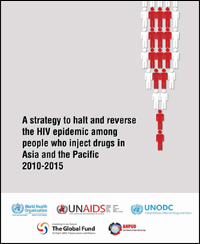Strategy to halt and reverse the HIV epidemic among people who inject drugs in Asia and the Pacific
 Bangkok (Thailand), 7 July 2010 - After having been proposed by the World Health Organization, a new regional strategy for HIV prevention, treatment and care for people who inject drugs in Asia and the Pacific has been developed by the United Nations Regional Task Force on Injecting Drug Use and HIV/AIDS for Asia and the Pacific.
Bangkok (Thailand), 7 July 2010 - After having been proposed by the World Health Organization, a new regional strategy for HIV prevention, treatment and care for people who inject drugs in Asia and the Pacific has been developed by the United Nations Regional Task Force on Injecting Drug Use and HIV/AIDS for Asia and the Pacific.
The regional
strategy is a road map for Member States, civil society and development agencies on how to successfully address the HIV epidemic among people who inject drugs in Asia and the Pacific.
The strategy calls for rapid expansion of the recommended interventions for this population, including: needle and syringe programmes, opioid substitution therapy and increased access to antiretroviral therapy.
The strategy also calls for Member States to plan and initiate evidence-based responses to the emerging challenges ahead, specifically the co-infection with hepatitis C and the increasing use of methamphetamines in the region.
Gary Lewis, UNODC Regional Representative, said that "the new strategy is a call to action. Member States are encouraged to make universal access to HIV prevention, treatment and care a reality for people who inject drugs".
This new strategy is an additional tool that can be utilized by Member States in their efforts to achieve
Millennium Development Goal 6 and to advance interventions for the control of the HIV epidemic by 2015.
UNODC is very proud to have been involved in the development of the document and will now shift its focus towards the implementation of the strategy in East Asia and the Pacific.
Project collaborators: The United Nations Regional Task Force on Injecting Drug Use and HIV/AIDS for Asia and the Pacific, the
World Health Organization, the
Joint United Nations Programme on HIV/AIDS, the
United Nations Office on Drugs and Crime,
The Global Fund to Fight AIDS Tuberculosis and Malaria and the
Asian Network of People who Use Drugs.
 Bangkok (Thailand), 7 July 2010 - After having been proposed by the World Health Organization, a new regional strategy for HIV prevention, treatment and care for people who inject drugs in Asia and the Pacific has been developed by the United Nations Regional Task Force on Injecting Drug Use and HIV/AIDS for Asia and the Pacific.
Bangkok (Thailand), 7 July 2010 - After having been proposed by the World Health Organization, a new regional strategy for HIV prevention, treatment and care for people who inject drugs in Asia and the Pacific has been developed by the United Nations Regional Task Force on Injecting Drug Use and HIV/AIDS for Asia and the Pacific.